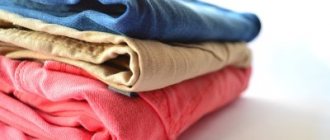Jeans are a universal wardrobe item that is available for adults and children. They do not need regular washing, but it is impossible to completely abandon it.
In order for a thing to last a long time, not fade or fade, it must be processed correctly.
Read the article on how to properly wash jeans by hand.
Features of denim
Classic denim is made from cotton twill weave. This fabric is very dense, with a characteristic relief, comfortable to wear. Denim is often supplemented with threads with a synthetic base: this adds new properties. Stretch jeans with polyester have excellent stretch and fit perfectly to the figure.
Caring for natural and blended denim consists of a number of rules. The most basic ones are always indicated on the label.
How often to wash
Although no one forbids washing jeans every day, frequent contact with water and detergent will cause the fabric to lose its elasticity and color faster. The less frequently we wash our jeans, the longer they last. But this does not mean that you need to stay in your pants for a whole month, and only then wash off the ingrained layer of various dirt. Washing is always commensurate with wear: worn a little, then washed.
It is better to wash new jeans immediately after purchase. Local stains should be washed by hand in a basin, so as not to spin generally clean trousers in the drum.
Advice A sure sign that jeans need cleaning is a stretched waistband or slightly protruding knees. After drying, the shape will be restored.
Important Tips
To prevent hand washing from causing damage to the product, you must adhere to the following recommendations:
- You need to soak and wash dark and light pants separately from each other.
- Before you start washing, you should study the manufacturer's recommendations for caring for the product.
- The more glued elements (sequins, beads, rhinestones) on the pants, the less they should come into contact with water.
- You can make the fabric of your jeans softer by rinsing them in water with conditioner.
- White jeans need to be washed more often than black ones. To prevent them from turning yellow or gray, oxygen bleach is periodically added to the water.
- If jeans have leather inserts, rub them with glycerin before washing. This will prevent cracks from appearing.
- Ripped jeans have come into fashion in recent years. Such products are especially susceptible to friction. Therefore, they cannot be treated with a brush. Rubs torn jeans with soft sponge washcloths.
- If your jeans feel tight after washing, you can quickly stretch them. To do this, you need to put on pants, moisten the fabric with water from a spray bottle and move actively.
Sometimes the material becomes rough after washing. This can be corrected using a steamer. If it is not at hand, then cover the pants with damp gauze and iron them, setting the toggle switch to the minimum temperature.
Washing rules
For any type of washing, try to use cold, or maximum warm, water. Jeans need to be prepped a bit before soaking or cycling in the machine.
Preparation
Check your pockets and remove anything unnecessary. It is better to fasten zippers and buttons. If you machine wash on the standard cycle, turn the pants inside out so that the front side experiences less friction. Be sure to turn decorated trousers inside out.
If there are difficult stains, for example, grass or berry juice, then wet them with water and soap them with laundry soap. Antipyatin soap for colored laundry works well on jeans.
Wash by hand
Hand washing is a priority if jeans are prone to shedding and contain synthetic threads.
How to wash by hand:
- Dissolve the detergent in a large bowl. The jeans should be completely submerged in water. Temperature - 30-40 degrees.
- Soak the prepared pants for 40-50 minutes.
- “Massage” your pants with light movements, paying attention to the seams, pockets, knees, waistband - those places that get dirty the most.
- Drain the solution and rinse thoroughly in running water.
- Squeeze gently. You can twist it, but moderately.
- Shake off the moisture, straighten your pants and set them to dry.
Machine washable
It is important what mode the jeans will be washed on. Consider the composition of the fabric.
How to wash denim in a machine:
- Choose manual or delicate mode. “Cotton” at 30-40 degrees is suitable.
- Reduce the spin speed to minimum if you want to save your pants.
- To avoid overloading the drum, do not wash more than 3-4 pairs at a time. Cotton jeans become heavy when wet.
- Don't neglect additional rinsing.
- Avoid machine drying.
How to wash jeans
For hand washing, it is advisable to select products based not only on their cleaning properties, but also on their effect on the skin of the hands:
- Jeans can be washed with regular laundry soap. It cleans fabric well of dirt and copes with complex organic stains on clothes. It is made from natural fats of animal origin, which is important for the skin of the hands.
Laundry soap effectively removes dirt during hand washing and cares for the skin of your hands.
- Special laundry detergents made from ingredients of plant origin are safe for health. It’s good if the label contains a mark indicating compliance with SAN PIN standards.
Synergetic is a safe product that can even be used for washing children's clothes.
- It is convenient to clean jeans with a brush. For dense fabrics, a stiffer one is suitable, but for thin and elastic ones, it is better to take a brush with soft bristles. You can use a household sponge.
- If the product has an unstable color, the last rinse should be done in a vinegar solution: 1 tablespoon per liter of water. This will help preserve the color.
Any liquid detergent is suitable for machine washing. They dissolve well in water and are easier to rinse without leaving marks on clothes. You can use special gels for washing denim, which are designed taking into account its characteristics.
A special product for denim will protect clothes from color loss and make them soft after washing.
When purchasing liquid detergent, focus on color and smell. Open the cap and check that the liquid is white or neutral in color. The brighter it is, the more unnecessary dyes it contains. A pleasant smell is also a sign of excess chemicals. Manufacturers guarantee frosty freshness or the smell of lemon, but this will not affect the quality of the wash.
Table: overview of detergents for denim clothes
| Name | Manufacturer | Release form, volume | Compound | Characteristics of the product | pros | Minuses | Price |
| Bagi Jeans | Bagi, Israel | Gel concentrate, 1 l. |
|
|
| High price | From 320 rubles |
| Domal Jeans | Domal, Germany | Concentrated gel, 750 ml | Does not contain harsh chemicals |
|
| High price | From 408 rubles |
| BiMax Jeans | BiMax, Russia | Concentrated gel, 1.5 l. | Surfactants and dietary supplements |
|
| After the first or second wash, the color change is not noticeable. | From 464 rubles |
| Dreft Black | Dreft, Belgium | Gel, 3 l. |
|
|
| High price | From 754 rubles |
| Luxus professional |
| Gel, 1 l. | Surfactants and phosphates |
|
|
| From 235 rubles |
| Wellery DELICATE Color | New Chemical Technologies LLC, Russia | Gel, 1 l. | Surfactant, does not contain phosphates and dyes |
|
| Not always on sale | From 220 rubles |
| Amway Home SA8 Black | Amway | Gel, 1 l. |
|
|
| High price | From 1300 rubles |
Video: which product removes dirt better
Typical washing mistakes
Banal laziness or ignorance of the features of jeans leads to minor troubles, and if you are unlucky, then to damage to the pants beyond repair. Don't make these mistakes like other housewives.
Washing with other items
Washing classic blue jeans with white clothes, even at 30 degrees, is a big risk. After such a mistake, housewives take a long time to remove blue stains from T-shirts and shirts.
Wash jeans only with similar fabrics, preferably of similar composition, following the instructions on the labels.
Heat
Washing at 60 degrees or higher often causes jeans to fade, especially if they are black or deep blue.
There is another problem: the fabric shrinks. You risk simply not fitting into your favorite trousers.
Incorrect spin
If you set the washing machine to the most powerful spin, thin jeans may not withstand the load and tear. Reduce speed to avoid excessive wrinkling of the fabric.
Incorrect washing mode
Natural cotton jeans on the “Wool” or “Synthetic” mode may not wash.
Various tricks
By following certain rules for caring for good jeans, you can actually wear them for more than one or even two years. Interesting fact: this material in trousers can adapt to even small changes in a person’s figure. This applies primarily to the fact that the changes will not be too significant.
If the owner of the jeans has lost weight, but the pants themselves have stretched, then this situation can be saved as follows:
1. You can wash this item directly on yourself. To do this, you need to sit in your jeans in a bathtub with not very hot water, lather a sponge or your own hand with any soap and gently rub the fabric with it. After this, without removing the item from yourself, you must also rinse it on yourself with clean water. Now let the jeans dry again directly on the body.
This method is appropriate only when the ambient temperature is quite high, that is, in the hot season, since at lower temperatures the item will dry out for a very long time.
Jeans washed this way will fit your figure just perfectly.
via GIPHY
2. You can speed up the drying of jeans using a special mode available in the washing machine. You can also reduce the size of various individual elements, for example, elongated places on the knees, or the entire thing.
There is also a solution if your jeans become too small for you:
To do this, you need to lightly moisten them with a spray bottle or simply sprinkle them with water and then put them on yourself. Wait until the jeans dry on you, and you will notice that they themselves stretch out in the places that you need.
It doesn’t matter if you have gained a lot of weight and the moment comes when you are unable to button up your favorite trousers. In this case, it is also recommended to wet only the belt and the waist area of the trousers with water and stretch this area as much as possible with the help of books inserted between the fabric and your body.
3. Are you a conservative and always buy the same model every year, but it suddenly suddenly disappeared from sale? No problem! Don’t despair too much, you can still continue to buy it the same way you used to do it before. Pay attention to the label located on the inside of the trousers. On it, if it has not been erased, of course, as a rule, there is information and all the data specifically about your trouser model. You can simply find them on the Internet and purchase them again.
How to dry properly
The final stage of washing is proper drying. For most fabrics, natural drying is a priority, and denim is no exception.
All drying rules:
- Straighten out any creases.
- Hang your pants or place them on the dryer.
- Do not dry on a radiator or in a dryer. Over-drying harms the fibers and makes them brittle. For the same reason, ironing is harmful to jeans.
- To prevent your pants from fading in the sun, turn them inside out if you dry them outside in the summer.
Problems with lightning
© Rath/Getty Images
- If suddenly the zipper on your jeans suddenly stops working, then a graphite pencil can come to your rescue, which you need to draw along the entire length of the zipper. If suddenly the pencil was unable to cope with this problem, then you can move on to other lubricants, which could be soap, a drop of oil or hygienic lipstick.
- If the lock on your trousers does not stay on top and is not fastened all the way, then a saving solution for some time can be a ring from your key ring, which can be attached to the zipper slider, and then hooked to the top button. This way, your trousers will no longer unbutton on their own when not needed.
- If some teeth are missing on the zipper of your trousers, you are unlikely to be able to fasten your jeans properly. In this case, the zipper should be replaced with a new one. But in some situations, if there is no tooth at the very end of the zipper, you can do without replacement. The slider should be fastened so that it is slightly higher than the damage site. Now you can make a few stitches with a needle and thread above the place where the tooth is missing.
- You can also carefully remove the damaged lock and make a clasp that will fasten with buttons.
- If at the most inopportune moment the slider on the lock of your jeans comes off, without which it will be almost impossible or very problematic to fasten them, then as some kind of temporary solution you can attach a paper clip or a ring from a key ring instead.
Changing jeans size
We use all the tips in reverse to reduce stretched jeans. Tricks will also come in handy for those who have lost weight by 1-2 sizes, but do not yet have the opportunity to update their wardrobe.
Shrinkage
Wash your jeans in a machine at 60 or even 90 degrees. The more cotton in the composition, the higher the likelihood of shrinkage. A radical method is boiling in a saucepan, but this is only suitable for the most durable denim.
Stretching
To stretch pant legs, work with the fabric while it is wet. Simply secure the waistband and give the bottom a good tug. Leave to dry in this position, you can additionally secure the pant legs.
Another way is to steam your jeans well and put them on yourself.
Storage
Learning how to wash your pants correctly is only half the battle. You also need to learn how to store them correctly. Most people make the same mistake over and over again: folding items and storing them in a stack.
We forget that in this way the fabric in the folds will wear out faster. In fact, jeans deserve the same careful treatment as trousers with creases. If you want to store your trousers correctly, they should be hung in the closet on hangers with clothespins.
If it is not possible to wash or washing is prohibited
It is worth listening to the opinion of famous denim designers, such as the creator of the Levi's brand, Levi Strauss: to make jeans last for several years, wash them once every 2 months. There is no point in taking this advice to the point of absurdity, because today the fabrics of jeans vary greatly in composition, and the thing is so comfortable that you want to wear it every day. But you can take note of some tricks that will reduce the number of washes.
Dry cleaning
Folk remedies for dry and wet cleaning are salt, soda, hydrogen peroxide, ammonia, vinegar solution and others. Can be used without water. To remove traces of the product, use a vacuum cleaner, an alcohol wipe, or simply wait until it dries.
Local wet cleaning
Stains can be treated with soapy water, dish soap (it effectively removes greasy marks), or soda slurry. Use a soft sponge or brush, be sure to rinse off the product with water.
Ventilation
An alternative to frequent washing is long-term airing. This method will help when there are no visible stains on the jeans, but body odor remains. The smell on the balcony will disappear within 24 hours.
Caring for your favorite clothes
© Rogerio Martins/Pexels
If you choose the right type of jeans, they will highlight your figure and also hide some of its flaws. Plus, they will also easily approach a variety of things. Finding such trousers is not always easy the first time, but if you succeed, then you will, as a rule, wear them for many years, practically without taking them off.
- Always buy jeans half a size smaller than necessary, or even a whole size. Ideal jeans should be difficult to fasten after purchase when you first put them on, but literally after a few days they stretch, hugging your figure. But don’t overdo it, because jeans that are too tight can interfere with your blood circulation and can also cause swelling or some other illness in your body.
- Wash your pants as often as possible.
- If you notice that a shine has begun to appear on your jeans, then you need to moisten them with a weak solution of ammonia, then apply washing powder, and only after that you can proceed directly to washing.
Rules for drying and ironing
The appearance and condition of jeans can be affected not only by how they were washed, but also how they were dried.
To preserve shape and color, the item is dried in air, in a well-ventilated area, but avoiding exposure to sunlight. Trousers made of thin fabric or stretch are recommended to be dried horizontally, spread out on the fabric.
All other jeans should be dried by pinning the waistband or pant legs to a line. This way the item will dry faster and more evenly.
There is no need to iron your jeans. If they are dried flat, they will easily straighten out on the body.
If the condition of the fabric requires the use of an iron, then iron it from the inside out, slightly moistening the fabric. The iron should be turned on at minimum heat.
It’s even easier to use a steamer, this will get rid of possible creases.
Things to remember
- Wash the item in cold or warm water no higher than 60C. Hot water washes away color pigments.
- Soak very dirty clothes in a weak solution of vinegar or salt to set the dye.
- Dry the items from the reverse side in the shade . Direct sunlight causes cotton fabric to fade.
- Iron from the wrong side.
- Choose cleaning products in liquid form . This way, traces of powder stains will not remain on your clothes.
- First dilute the washing powder in water , and then use a brush to clean the dirt.
- jeans with decorations (rhinestones, rivets, embroidery) without soaking.










